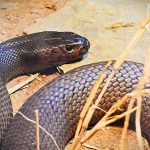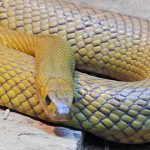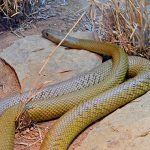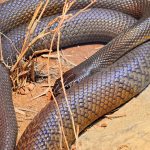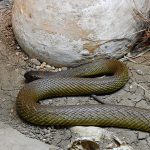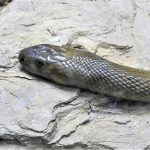INLAND TAIPAN
The Inland Taipan
The Inland Taipan, also known as the Fierce Snake, is a highly venomous snake species native to central Australia.
Physical Characteristics
It is a relatively large and slender snake, with adults reaching an average length of 1.8 to 2.5 meters. It has a small, rounded head and a slender body. The snake’s coloration can vary from light tan to dark brown, with some individuals exhibiting shades of olive or grey. It has smooth scales and a lighter-coloured belly.
Habitat and Distribution
The Inland Taipan inhabits arid and semi-arid regions of central Australia, including Queensland, South Australia, and the Northern Territory. It prefers open grasslands, shrublands, and arid desert environments, often found in association with spinifex grass and rocky outcrops. It’s range is limited to the central parts of Australia, primarily in remote and sparsely populated areas. It is not found along the coastal regions or in the southern parts of the country.
Behaviour
Inland Taipans are predominantly diurnal, meaning they are active during the day. They are highly elusive and tend to avoid human encounters. When threatened, they may flatten their bodies, hiss, and display an S-shaped defensive posture. They are known to be extremely fast and agile.
Venom and Interaction with Humans
The venom of the Inland Taipan contains a mix of neurotoxins, procoagulants, and myotoxins. The venom is primarily designed to immobilize and kill small mammals, such as rodents. It can cause rapid paralysis and internal bleeding in its prey. Bites from an Inland Taipan are extremely dangerous to humans and can be lethal if left untreated.
Diet
Inland Taipans primarily feed on small mammals, with their primary prey being rats and mice. They are highly efficient hunters and can detect the scent trails of their prey. They use their venom to quickly immobilize and subdue their prey before consuming it.
Breeding
The Inland Taipan is oviparous, meaning it lays eggs. The female typically lays a relatively small clutch of around 6 to 14 eggs in a protected location, such as burrows or crevices. The incubation period lasts for approximately 2 to 3 months, after which the eggs hatch, and the young snakes emerge.
The Inland Taipan populations are naturally sparse due to its restricted range and the harshness of its habitat. It is protected under wildlife conservation legislation in Australia.
It’s important to note that the Inland Taipan is an extremely venomous snake, and encountering one in the wild should be avoided.

